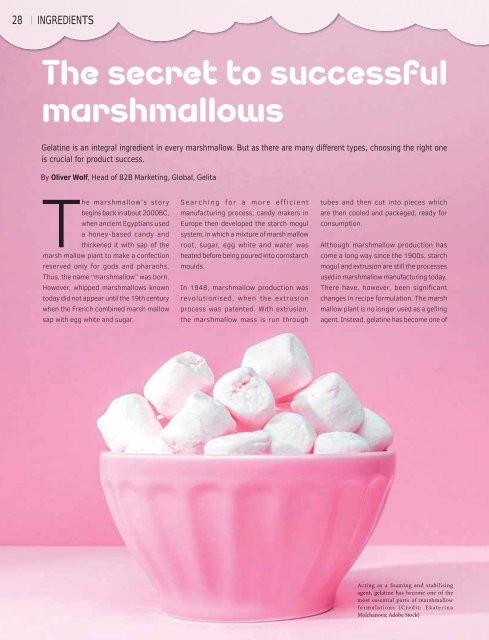Food & Beverage Asia June/July 2020
Food & Beverage Asia (FBA) is the leading source of food and beverage news in Asia since 2002. FBA delivers a comprehensive view of the food and beverage landscape, spanning across the latest health and nutrition trends and industry innovations in ingredients, recipe formulations, food science, sustainability, packaging, and automation, as well as advancements in agri and food-tech.
Food & Beverage Asia (FBA) is the leading source of food and beverage news in Asia since 2002. FBA delivers a comprehensive view of the food and beverage landscape, spanning across the latest health and nutrition trends and industry innovations in ingredients, recipe formulations, food science, sustainability, packaging, and automation, as well as advancements in agri and food-tech.
Create successful ePaper yourself
Turn your PDF publications into a flip-book with our unique Google optimized e-Paper software.
28<br />
INGREDIENTS<br />
Gelatine is an integral ingredient in every marshmallow. But as there are many different types, choosing the right one<br />
is crucial for product success.<br />
By Oliver Wolf, Head of B2B Marketing, Global, Gelita<br />
The marshmallow’s story<br />
begins back in about 2000BC,<br />
when ancient Egyptians used<br />
a honey-based candy and<br />
thickened it with sap of the<br />
marsh mallow plant to make a confection<br />
reserved only for gods and pharaohs.<br />
Thus, the name “marshmallow” was born.<br />
However, whipped marshmallows known<br />
today did not appear until the 19th century<br />
when the French combined marsh mallow<br />
sap with egg white and sugar.<br />
Searching for a more efficient<br />
manufacturing process, candy makers in<br />
Europe then developed the starch mogul<br />
system, in which a mixture of marsh mallow<br />
root, sugar, egg white and water was<br />
heated before being poured into cornstarch<br />
moulds.<br />
In 1948, marshmallow production was<br />
revolutionised, when the extrusion<br />
process was patented. With extrusion,<br />
the marshmallow mass is run through<br />
tubes and then cut into pieces which<br />
are then cooled and packaged, ready for<br />
consumption.<br />
Although marshmallow production has<br />
come a long way since the 1900s, starch<br />
mogul and extrusion are still the processes<br />
used in marshmallow manufacturing today.<br />
There have, however, been significant<br />
changes in recipe formulation. The marsh<br />
mallow plant is no longer used as a gelling<br />
agent. Instead, gelatine has become one of<br />
Acting as a foaming and stabilising<br />
agent, gelatine has become one of the<br />
most essential parts of marshmallow<br />
formulations (Credit: Ekaterina<br />
Molchanova; Adobe Stock)


















